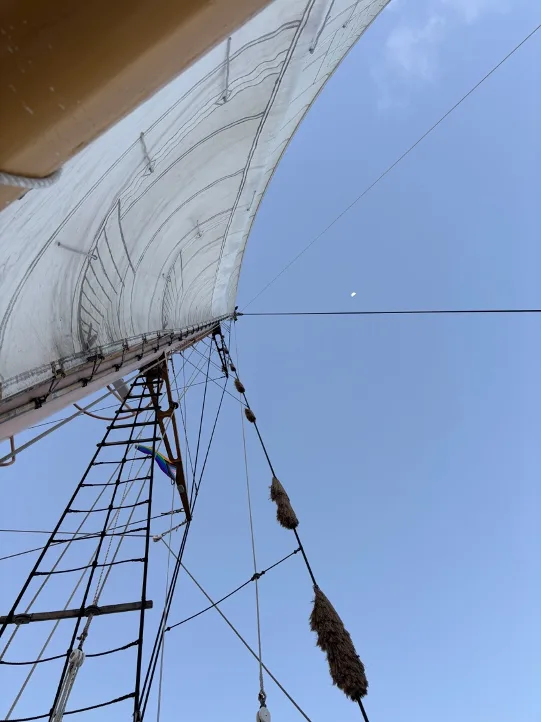Programs Blog
Under the Stars

July 10, 2025
Time: 1941
Location: Around 500 nautical miles south of Hawai’i
Weather: Clear for the first time in a few days
I feel like a lot of my blogs have been about daily events so today I am going to shake it up a bit: here is everything I have learned about the stars.
Rocky, one of the mates, is an amazing teacher when it comes to this subject, so most of this information comes from him. He has helped me learn a bunch of constellations, such as Libra, Scorpio, the summer triangle (which isn’t technically a constellation but I’m not nit picky), centaur, the southern cross, and my personal favorite, Maui’s fishhook. If you aren’t familiar with Maui’s fishhook, it is the tail of Scorpio in the western constellations. It is one of many Polynesian constellations, such as ‘Iwo Keli’I, which is the Chief Frigate Bird and consists of the western constellation of Cassiopea, and Ka Lupe Okawelo, which is the kite or sting ray.
Polynesians have used the stars to navigate the ocean for thousands of years. One of the aspects of this is using your hands to measure the stars, which we also do on the ship. For example, vertical fist is around ten degrees, and a shaka is around twenty. One way to find your latitude in the Northern Hemisphere is to find how many degrees the North Star, Polaris, is above the horizon. So, if Polaris is about one fist, or 10 degrees, above the horizon, then you are at around 10 degrees North for latitude. You may be thinking “But everyone has a different sized hand?” Well, I am here to tell you that while there is some variation from person to person, the thing is if you have a smaller hand, you probably also have a shorter arm, so your hand is closer to your face, and therefore appears larger, than someone with a longer arm. So, measurement doesn’t vary all that much from person to person.
If you remember, earlier I mentioned that the southern triangle is not technically a constellation. That is because the word “constellation” refers specifically to the 88 western constellations, such as Scorpio and Ursa Major. Any other picture in the sky is called an asterism (I believe that is the word, but I don’t have the internet, and I don’t want to wake up Rocky right now). Asterisms include constellations from any other culture, or star patterns that are referred to without being in the official 88. I don’t love this definition, so I will not be adhering to it for the remainder of this blog post.
We have also learned a lot of individual stars. This is because we use a lot of stars to determine our location using a sextant. Sextants are just another tool to measure the angle of celestial bodies and therefore determine your latitude. We do this by comparing the known angles of stars at certain latitudes to our measured angles. We use specific stars for this since, well, there is no book long enough for the angles of every star. So, I have learned to recognize the Deneb, Regulus, and Antaries.
The night sky is one of my favorite parts of being out at sea. I feel super lucky that I get to see the Milky Way almost every night with almost no light pollution. I am super pumped to wake up in like 4 hours and look at them for dawn watch (and so my watch begins). Thank you for reading all I have learned about the stars so far!
Loved ones shout out: I am doing great. I’m super enjoying boat life, but I am also so excited to see you in just a few days. I love and miss you tons.
Big hugs to my friends, family, boyfriend, and dog. You all know who you are.
Peace and love and love and peace,
Sophie Wilcox
B Watch
Purdue University
Recent Posts from the Ships
- Ocean Classroom 2024-A collaborative high school program with Proctor Academy
- Collaborations and Long-term Commitments: SEA’s Caribbean Reef Program Sets a Course for Coastal Programs that Compliment Shipboard Experiences.
- Sea Education Association students prepare for life underway using state of the art nautical simulation from Wartsila Corporation.
- SEA Writer 2022, Magazines From the Summer SEA Quest Students
- Technology@SEA: Upgrades Allow Insight into Ocean Depths
Programs
- Gap Year
- Ocean Exploration
- High School
- Science at SEA
- SEA Expedition
- SEAScape
- Pre-College
- Proctor Ocean Classroom
- Protecting the Phoenix Islands
- SPICE
- Stanford@SEA
- Undergraduate
- Climate and Society
- Climate Change and Coastal Resilience
- Coral Reef Conservation
- Marine Biodiversity and Conservation
- MBL
- Ocean Exploration: Plastics
- Ocean Policy: Marine Protected Areas
- Oceans and Climate
- Pacific Reef Expedition
- The Global Ocean: Hawai'i
- The Global Ocean: New Zealand